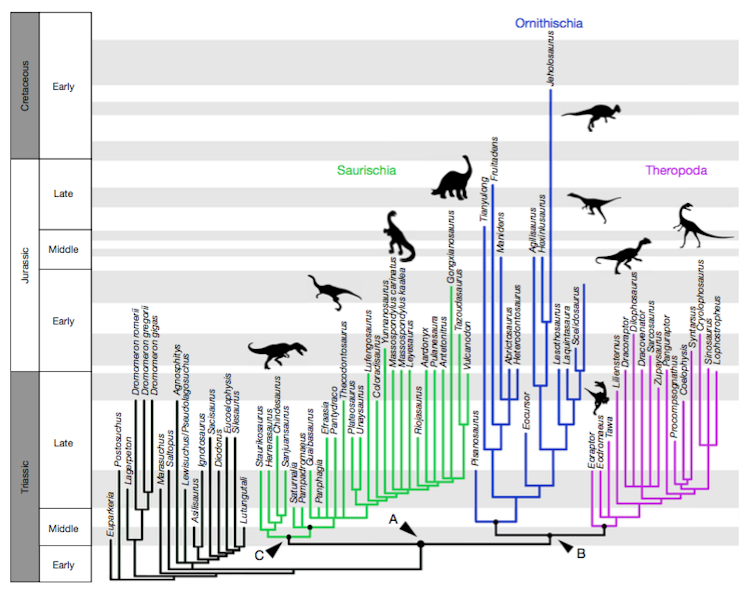Which Modern Group Of Animals Do Some Scientists Think Of As A Subgroup Of Dinosaurs
Normally the dinosaurian world is rocked by a new fossil – the biggest, fastest, or toothiest. But the latest dinosaur enquiry threatens to change our understanding of how dinosaurs evolved at a much deeper level, and accident bated 130 years of agreement on the topic.
A new paper published in the periodical Nature suggests that scientists demand to reorganise the major groups used to classify dinosaurs. This means we may have to revisit what we remember we know almost the commencement dinosaurs, what features they evolved first, and where in the world they came from.
The fashion nosotros classify dinosaurs goes dorsum to the 19th century. In 1887, Harry Govier Seeley, a archetype, hard-working Victorian palaeontologist, divided dinosaurs into two major suborders based primarily on their hip structure. Saurischia comprises the flesh-eating theropods such equally Tyrannosaurus and the ponderous, long-necked sauropodomorphs such as Diplodocus. Ornithischia comprises all the rest, including the two-legged Iguanodon, and the armoured, four-legged Stegosaurus, Triceratops, and Ankylosaurus.

This ordering of dinosaurs has stood the test of time for 130 years, weathering the onslaught of cladistics in the 1980s, when palaeontologists began using computers to analyse and categorise groups of animals based on features that pointed to a common ancestor. There are now thousands of diagrams (cladograms) of dinosaur subgroups, and ever-growing data matrices, that closely document the anatomical features of each species.
The new paper completely disrupts the consensus over Seeley's categories. The researchers ran a cladistic analysis of 457 characteristics across 74 species (that is a data matrix of 33,818 bits of information recorded from skeletons). They concluded that, based on 21 unique characteristics of the fossils, the theropods were more than closely related to the Ornithischia group and should exist moved into that category. This would create a new group named Ornithoscelida and exit behind the Sauropodomorpha.
The trick in cladistics is to detect a unique anatomical feature that evolved at a specific time and can indicate a particular subgroup. For case, Seeley noted that the hip basic of ornithischians were arranged with pubis and ischium running backwards (superficially, similar modernistic-solar day birds). Meanwhile, the hip basic of saurischians (including theropods) matched other reptiles, with pubis frontward and ischium back.

This suggests the two groups dissever from a common ancestor and evolved different hip shapes. This was a massive anatomical change or novelty, and palaeontologists until now have assumed that it happened but in one case in evolutionary history. Group the theropods with the ornithischians suggests that the hip change occurred later and raises the question of whether some early theropods had this characteristic.
The researchers also propose that the new analysis can reset our agreement of where dinosaurs originated and what their nutrition was. The archetype view was that the first dinosaur was a carnivore living in what is now South America. The new assay makes this more than of an open question and suggests they might have evolved as omnivores in the northern hemisphere.
Tree of life
None of this changes what nosotros know for certain nigh what dinosaurs evolved which traits and when. But the key point is that accurately depicting the tree of life matters. If you care most modernistic biodiversity, it's important that all species are not equal. Some are more than distinctive than others, possessing more unique features, and having a longer contained history. Working this out requires an accurate tree.
On a broader scale, getting the tree correct affects our calculations of rates of trait evolution, extinction and post-extinction recoveries. Nosotros will never find the very first dinosaur but nosotros can constitute some things about it by estimating the bequeathed states of different species from a correct tree.
We invest enormous efforts into constructing testable systems for categorising unlike species, and their size is increasing equally computing ability grows. When I ran my first cladogram in 1982, I had to use punch cards on a mainframe computer, and I could include simply ten or 12 species and fifty or and so characteristics.
Today, I was able to run all the information for this new paper through my desktop reckoner and get an answer in 33.21 seconds, while writing this commodity at the same time. Contempo publications have sported trees of all x,000 species of birds, and even summary trees of all life. The dream is to run such trees with all 1.5m named species, using information near both genes and concrete shape.
Is this new paper the true reply for the evolutionary origins of dinosaurs? The information we accept is riddled with question marks, and so the algorithms still struggle to calculate the i truthful tree. This is no criticism of the researchers, just a statement of the practicalities. Nosotros don't know however whether we can run into the forest for the trees.
Source: https://theconversation.com/we-might-have-to-completely-redraw-the-dinosaur-family-tree-75018
Posted by: hunsuckermilitaidele1997.blogspot.com

0 Response to "Which Modern Group Of Animals Do Some Scientists Think Of As A Subgroup Of Dinosaurs"
Post a Comment